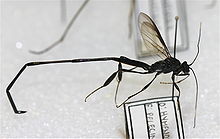
Chalcid wasps are insects within the superfamily Chalcidoidea, part of the order Hymenoptera. The superfamily contains some 22,500 known species, and an estimated total diversity of more than 500,000 species, meaning the vast majority have yet to be discovered and described. The name "chalcid" is often confused with the name "chalcidid", though the latter refers strictly to one constituent family, the Chalcididae, rather than the superfamily as a whole; accordingly, most recent publications (e.g.,) use the name "chalcidoid" when referring to members of the superfamily.

Diplolepis is a genus of approximately fifty species in the gall wasp family Cynipidae. The larvae induce galls on wild roses (Rosa), and rarely on domestic roses.

Pelecinus polyturator is a species of wasp in the family Pelecinidae. The large glossy black insects are the most common and well-known members of the family. The adults drink nectar, and they live in crop fields, woods, and suburban gardens throughout North, Central, and South America. Their antennae are long and the females have an elongated, cylindrical, articulated metasoma. They are parasitoids that lay their eggs directly into grubs of the June beetle buried in the soil. The adults can be found in the late summer.

Pelecinidae is a family of parasitic wasps in the superfamily Proctotrupoidea. It contains only one living genus, Pelecinus, with three species known from the Americas. The earliest fossil species are known from the Jurassic, and the group was highly diverse during the Cretaceous. Members of Pelecinus are parasitic on larval beetles, flies, green lacewings, and sawflies.
Tachysphex pechumani is a species of wasp in the family Crabronidae. It is endemic to North America.

Dryocosmus are a genus of gall wasps. They are cyclically parthenogenetic insects that induce galls on plants in the family Fagaceae.

Leptofoenus is a genus of wasp in the family Pteromalidae, the type genus subfamily Leptofoeninae found in South America, Central America, and southern North America. The genus contains five living species and one extinct species known from early Miocene Burdigalian stage Dominican amber deposits on the island of Hispaniola. With body sizes ranging from 11–27 millimetres (0.43–1.06 in) Leptofoenus species are larger than nearly all other species in Pteromalidae. The genus bears a notable resemblance to the wasp families Pelecinidae, Gasteruptiidae, and Stephanidae.

Cynips is a genus of gall wasps in the tribe Cynipini, the oak gall wasps. One of the best known is the common oak gall wasp, which induces characteristic spherical galls about two centimeters wide on the undersides of oak leaves.

The Ibaliidae are a small family of hymenopteran superfamily Cynipoidea. Ibaliidae differ from most of the cynipoids by the larvae being parasitoids on other wasp larvae in the group Siricidae. The Ibaliidae comprise three extant genera of fairly large wasps, with a total of 20 species, and is a sister group to the rest of the cynipoids except the small subfamily Austrocynipidae.

Cynipini is a tribe of gall wasps. These insects induce galls in plants of the beech and oak family, Fagaceae. They are known commonly as the oak gall wasps. It is the largest cynipid tribe, with about 936 to 1000 recognized species, most of which are associated with oaks. The tribe is mainly native to the Holarctic. Cynipini wasps can act as ecosystem engineers. Their galls can become hosts of inquilines, and the wasps themselves are hosts to parasitoids.

New Jersey Amber, sometimes called Raritan amber, is amber found in the Raritan and Magothy Formations of the Central Atlantic (Eastern) coast of the United States. It is dated to the Late Cretaceous, Turonian age, based on pollen analysis of the host formations. It has been known since the 19th century, with several of the old clay-pit sites now producing many specimens for study. It has yielded a number of organism fossils, including fungi, plants, tardigrades, insects and feathers. The first identified Cretaceous age ant was described from a fossil found in New Jersey in 1966.
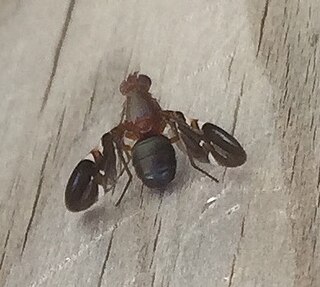
Delphinia picta is a species of picture-winged fly in the family Ulidiidae. The specific name picta is from Latin and means "painted." It is the only species in the monospecific genus Delphinia. It is found in the United States on the East Coast and in the Midwest from Florida to Maine across to Kansas through Minnesota but also can be found in Mexico and El Salvador. It is sometimes mistaken for a species of fruit fly, but D. picta do not feed on living plant matter, as they are detritivores and eat decaying plant matter. They also have been observed eating fermenting frass from Megacyllene robiniae on black locust trees. They can be found almost anywhere there is decaying vegetation: landfills, temperate deciduous forests, swamps, and even shaded fields.
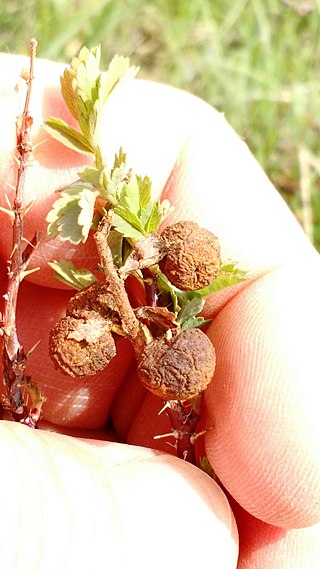
Diplolepis ignota is a species of gall wasp (Cynipidae). Galls in which the larvae live and feed are formed on the leaves of several species of wild rose (Rosa). Individual galls are single-chambered and spherical, but multiple galls can coalesce into irregularly rounded galls.
Striatoandricus is a genus of Neotropical gall wasps (Cynipidae). There are six described species, four of which were formerly included in Andricus. All species induce galls on oaks in which their larvae live and feed.
Burmese amber is fossil resin dating to the early Late Cretaceous Cenomanian age recovered from deposits in the Hukawng Valley of northern Myanmar. It is known for being one of the most diverse Cretaceous age amber paleobiotas, containing rich arthropod fossils, along with uncommon vertebrate fossils and even rare marine inclusions. A mostly complete list of all taxa described up until 2018 can be found in Ross 2018; its supplement Ross 2019b covers most of 2019.
Ceroptresini is a tribe of oak gall wasps in the family Cynipidae, and includes two genera: Ceroptres and Buffingtonella. All but one of the 22 species currently recognized are in Ceroptres. Ceroptresini, containing only Ceroptres, was first proposed as a tribe in 2015, and Buffingtonella was included the tribe in 2019 when the genus was first described. Species in this tribe are believed to be inquilines in galls induced by other gall wasps but this has not been confirmed.
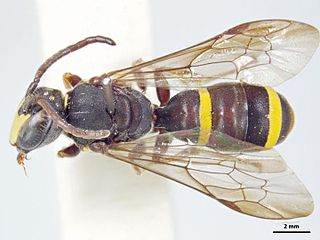
Hylaeus foveatus, a wasp-like bee, is a species of hymenopteran in the family Colletidae and the subfamily Analastoroides. It is found in Victoria and New South Wales in Australia.
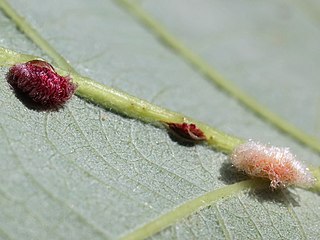
Druon is a genus of gall wasps in the family Cynipidae. The type species is Druon protagion. Recognised species include:

Druon ignotum is a species of gall wasp in the family Cynipidae.
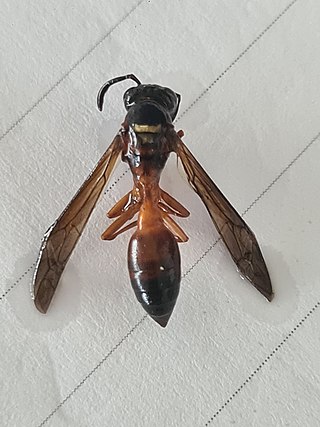
Angiopolybia is a genus from the tribe Epiponini. The species was originally described by R L Araujo in 1946.
